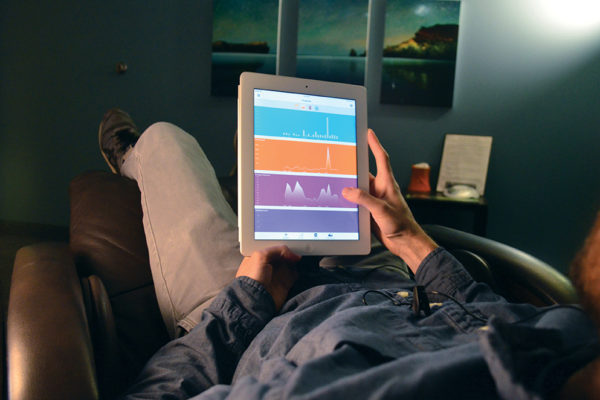On the second floor of the UT Administration Building, a cozy blue room serves as a small getaway for the university’s staff and faculty. The Stress Reduction & Biofeedback Center, run by the Employee Assistance Program (EAP), offers private appointments to UT employees every weekday.
The EAP strives to improve personal effectiveness by offering wellness resources and counseling services. At the Stress Reduction & Biofeedback Center, participants can observe how stress affects them in order to develop strategies to combat it.
“If your body is in a stress mode, then there’s a physiological response,” said Susan Harnden, manager of the Employee Assistance Program. “That fight, flight or freeze part of our brain gets triggered.
This response causes a broad range of issues, both seen and unseen.
“We tend to breathe shallower, our heart beats faster, and all of that has many effects. If you know how to calm your physiology, it opens up possibilities in calming your mood or even in changing the way you’re thinking,” said Harnden.
The center provides a zero-gravity chair, a device that tests skin temperature and a machine that tracks breathing and heart rates. This inexpensive and user-friendly technology gives users a sense of their physical reactions to stress. Participants can learn how to adjust their stress levels in real time. Practice can help them reach more calm and mindful states in the future.
Visitors first sit back in a chair that relieves the pressure points in the back. You can adjust it until your body feels most relaxed. This helps prepare you to use the machines that track your stress levels.
Once in the chair, you can measure your skin temperature. The device doesn’t give numbers, so the measurements are relative and self-tailored. It will give off a sound: If the sound is high-pitched, it means the user feels uneasy, stressed or anxious. This measurement can serve as a baseline. Keeping the sound in mind, you then return to the device at the end of your session to identify whether the pitch has changed. If the pitch is lower, it means the session has worked as designed and you have successfully relaxed.
Another machine guides your breathing levels. You strap a belt around your midsection and follow instructions on when to inhale and exhale. Noise-cancelling headphones are available to help you tune out everything around you. An additional guided breathing machine, with a small clip that goes around your earlobe, connects to a tablet. This device guides your breathing and checks your heart rate. It provides a chart that illustrates how your heart rate changes as you adjust your breathing.
These machines give users the reference points and experience needed to control their breathing and lower stress levels. The room also provides additional tools such as guided meditation applications and resources to help the user understand stress management. Employees can make appointments up to 45 minutes in duration, and there are no limits on how often you can use the facilities.
The EAP provides far more than these biofeedback services. The program began in 1992 and employs state-certified counselors available to staff and faculty members. It offers classes and activities throughout the year.
The EAP strives to improve personal and organizational effectiveness for the benefit of the entire UT community. Stress reduction plays an important role: According to recent studies in the Journal of Occupational and Environmental Medicine, mindfulness and stress management skills can improve employee job satisfaction, increase productivity and lower health care costs. The EAP helps employees develop these skills on an individual level and helps them address and mitigate any issues they may have.
“We teach strategies so that they just have a better understanding of how anxiety and depression and stress work,” Harnden said. “We help them to develop a plan or address barriers to managing their anxiety, stress and depression. We also help employees change their communication, whether that’s with a significant other, a parent, a child, other co-workers or a supervisor. We provide support and strategies for habit change, elder care and sleep hygiene.”
The counselors offer the services to a community of more than 20,000 staff and faculty members, so they tend to be busy all year. Harnden says they typically see a peak in clientele around October and February, a little after the semesters begin.
When demand increases, the EAP still tries to accommodate those who can’t come in for an appointment with a counselor. On their website, you can find multimedia guides to help you relieve stress at your desk. If you have a little more time to spare, you can always access their many services for a more robust experience.
“For me, 5 or 10 minutes feels like a longer break, so that’s energizing,” said Harnden. “Practicing the tools, personally, [helps me] more than the biofeedback. It teaches me how to do this in a way that fits my lifestyle. I find that most useful.”





